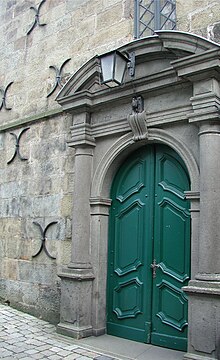Evangelical town church (Lennep)
The Evangelical City Church is the main Protestant church in Remscheid - Lennep in North Rhine-Westphalia .
history
The nucleus of today's city church was the chapel of a Fronhof consecrated to St. Nicholas, which was donated to the St. Kunibert Monastery in Cologne by the Duke of Limburg in the 13th century . In the liber valoris around 1300 no parish church in Lennep was mentioned, only a capella . Lennep did not have his own parish church, consecrated to St. James the Elder , until the 14th century; the patronage was held by the Kunibertsstift. In addition to the main altar , consecrated to St. James, the church had a side altar , consecrated to St. Nicholas , which was carried by the citizens. The mighty west tower in its basement, made of large rectangular blocks made of coal sandstone, still comes from this church .
The construction of the tower is dated to the 13th century. The church developed into a station on the Way of St. James . The Reformation was introduced around 1540 .
After the fourth Lennep city fire in 1746, the church had to be rebuilt. However, this only took place from 1750 to 1756. The church was built as a baroque, Protestant preaching church in the "Bergisch type". Wall or iron anchors , as they can be clearly seen on the church tower or gable , name the year 1753. The final conclusion of the work was the organ consecration in 1779. With a floor area of 27 × 18 meters, the Lennep town church is one of the large mountain preaching churches . Typical of the church is the principal structure of the altar, pulpit and organ, which are arranged one above the other. The church tower has a base area of 8 × 8 meters and a height of 51 meters. It consists (such as the nave ) of rubble stones , imprinted with its verschieferten , octagonal and with a tower Reiter provided onion dome to the district, and provides a distinctive and highly visible landmark is.
During both world wars the church remained intact.
organ
The organ was built by the organ builders Gebrüder Kleine in 1779 and extensively restored in 1980 by the organ builder von Beckerath ( Hamburg ). The instrument has 33 stops on two manuals and a pedal . The game actions are mechanical, the stop actions are electric.
|
|
|
||||||||||||||||||||||||||||||||||||||||||||||||||||||||||||||||||||||||||||||||||||||||||||||||||||||||||||||||||||||||||||||||||||||||||||||||
- Coupling : I / II, I / P, II / P
Bells
Three bells had been ringing since the 18th century, until two of the valuable bronze bells were confiscated and melted down for the armaments industry during the First World War . After the end of the war money was tight and so in the year of inflation the remaining bronze bell had to be given in payment in order to be able to order three steel bells from the Bochumer Verein in 1923 . The bell is tuned to B-Des-Fes.
literature
- Paul Clemen : The art monuments of the Rhine province , Volume 3, Section 2: The art monuments of the cities of Barmen, Elberfeld, Remscheid and the districts of Lennep, Mettmann, Solingen , L. Schwann, Düsseldorf 1894. u. a. P. 51–53 ( online at Digitale-sammlungen.de)
- Heinrich Otten: God's houses. Remscheid's churches in words and pictures , Remscheid 2008.
- Church leader of the Protestant parish Lennep
Web links
Individual evidence
- ↑ Information on the organ ( memento from September 19, 2013 in the Internet Archive ) on the website kirchenmusik-lennep.de, viewed May 6, 2012.
Coordinates: 51 ° 11 ′ 33.8 " N , 7 ° 15 ′ 28.6" E





